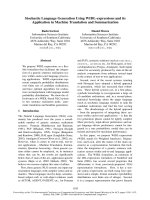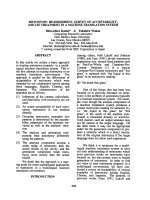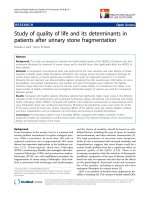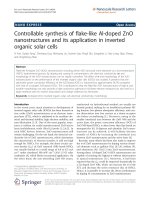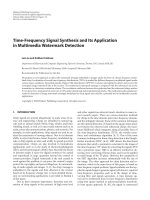Aqueous phase behaviour of surfactant and its application in cloud point extraction
Bạn đang xem bản rút gọn của tài liệu. Xem và tải ngay bản đầy đủ của tài liệu tại đây (1.52 MB, 111 trang )
AQUEOUS PHASE BEHAVIOR OF SURFACTANT AND ITS
APPLICATION IN CLOUD-POINT EXTRACTION
MAR MAR SWE
NATIONAL UNIVERSITY OF SINGAPORE
2003
AQUEOUS PHASE BEHAVIOR OF SURFACTANT AND ITS
APPLICATION IN CLOUD-POINT EXTRACTION
MAR MAR SWE
(B.Sc, Yangon University; B.E, Yangon Technological University)
A THESIS SUBMITTED
FOR THE DEGREE OF MASTER OF ENGINEERING
DEPARTMENT OF CHEMICAL & ENVIRONMENTAL ENGINEERING
NATIONAL UNIVERSITY OF SINGAPORE
2003
ACKNOWLEDGEMENT
Firstly, I would like to express my gratitude and deep thanks to my supervisors Dr.
Liya E. Yu and Dr. Chen Bing Hung for their patience, enormous support and
encouragement throughout this research project.
Secondly, I would like to thank all my lab-mates, my friends and the laboratory
officers in-charge in the Department of the Chemical and Environmental Engineering
(ChEE) for their kind support during my study.
Finally, I would like to express my sincere gratitude to the ChEE department for the
full permission to use the research facilities and the National University of Singapore
for providing the scholarship to pursue the Master of Engineering degree.
i
Table of Contents
TABLE OF CONTENTS
ACKNOWLEDGEMENT
i
TABLE OF CONTENTS
ii
SUMMARY
vi
NOMENCLATURE
viii
LIST OF FIGURES
xi
LIST OF TABLES
xiii
Chapter 1 Introduction
1
1.1 General Introduction
1
1.2 Objectives and Scope
5
1.3 Organization
7
Chapter 2 Literature Review
2.1 Solubilization by Nonionic Surfactants
8
8
2.1.1 Locus of Solubilization
8
2.1.2 Factors Affecting Solubilization
10
2.1.3 Quantitative Study on Solubilization
11
2.2 Aqueous Phase Behavior of Nonionic Surfactants
13
2.2.1 Mechanism of Clouding Phenomenon
13
2.2.2 Factors Affecting Cloud Point
13
2.2.3 Application of Clouding Phenomenon
15
2.3 Cloud-Point Extraction
15
ii
Table of Contents
2.4 Properties and Applications of Selected Nonionic
18
Surfactants
Chapter 3
2.4.1 Tergitol 15-S Series Surfactants
18
2.4.2 Neodol 25-7 Surfactant
19
Materials and Methods
21
3.1 Materials
21
3.2 Apparatus
22
3.2.1 HPLC
22
3.2.2 Laser Light Scattering
24
3.2.3 Water Bath
25
3.2.4 Centrifuge
25
3.3 Experimental Procedures
25
3.3.1 Equilibrium Solubilization
25
3.3.2 Micelle Size and Aggregation Number Measurement
26
3.3.3 Measurement of Cloud Point and Preconcentration Factor 28
3.3.4 Cloud-Point Extraction from Aqueous Solutions
Chapter 4 Solubilization by Nonionic Surfactants
29
31
4.1 Introduction
31
4.2 Results and Discussion
31
4.2.1 Equilibrium Solubilization of Hydrophobic Organic
31
Compounds by Selected Nonionic Surfactants
4.2.2 Determination of Micelle Size and Aggregation Number
41
of Selected Nonionic Surfactants
iii
Table of Contents
4.3 Conclusions
Chapter 5 Aqueous Phase Behavior of Selected Nonionic
46
47
Surfactants
5.1 Introduction
47
5.2 Results and Discussion
47
5.2.1 Aqueous Phase Behavior of Selected Nonionic
47
Surfactants
5.2.1.1 Tergitol 15-S-7 – Water system
48
5.2.1.2 Neodol 25-7 – Water system
48
5.2.1.3 Tergitol 15-S-9 – Water system
48
5.2.2 Effect of Added Electrolytes on Cloud Points of Selected
51
Nonionic Surfactants
5.2.3 Preconcentration Factor
5.3 Conclusions
Chapter 6 Cloud-Point Extraction and Recovery Efficiency
55
59
60
6.1 Introduction
60
6.2 Results and Discussion
60
6.2.1 Extraction by Tergitol 15-S-7
60
6.2.1.1 Recovery as a function of surfactant concentration
62
6.2.1.2 Recovery as a function of initial analyte concentration
64
6.2.2 Extraction by Neodol 25-7
65
6.2.2.1 Recovery as a function of surfactant concentration
67
6.2.2.2 Recovery as a function of initial analyte concentration
68
iv
Table of Contents
6.2.3 Extraction by Tergitol 15-S-9
69
6.2.3.1 Recovery as a function of surfactant concentration
70
6.2.3.2 Recovery as a function of initial analyte concentration
71
6.2.4 Comparison of Recovery Efficiency
6.2.4.1 Effect of molecular structure of surfactant on
72
72
recovery
6.2.4.2 Effect of different HLB values of surfactants on
74
recovery
6.2.5 Effect of Salts on Recovery Efficiency
6.3 Conclusions
Chapter 7 Conclusions and Recommendations
76
77
80
7.1 Conclusions
80
7.2 Recommendations
81
REFERENCES
83
APPENDX A Estimation of log Kow value of 9-chloroanthracene
95
v
Summary
SUMMARY
Solubilization of hydrophobic organic compounds (HOCs) by the readily
biodegradable nonionic surfactants, Tergitol 15-S-7 and Tergitol 15-S-9, mixtures of
secondary ethoxylated alcohols, and Neodol 25-7, a mixture of primary ethoxylated
alcohols, was investigated. The effects of the molecular structure and the HLB values
of the surfactants on the solubilization capacities of the HOCs were studied. The
results showed that the surfactant with a linear chain has a larger core volume and a
higher solubilization capacity compared to that of the branched surfactant. For the
surfactants of the same homolog, the HLB number could be used as a good indicator
for the solubilization capacity, because the surfactant with a lower HLB value has a
higher solubilization capacity. Micelle-water partition coefficients of HOCs were
correlated to their octanol-water partition coefficients. The correlation revealed that the
hydrophobicity of surfactants as well as the properties of solutes might also have a
profound influence on the micelle-water partitioning. The changes in the
hydrodynamic radii and the aggregation numbers of the micelles with temperature
were measured by the dynamic and static laser light scattering techniques. It is clearly
demonstrated that the solubilization capacity of HOCs was mainly governed by the
aggregation numbers and the core volume of the micelles of the selected nonionic
surfactants.
Cloud point temperatures of selected nonionic surfactants were studied along with the
effect of added electrolytes on their cloud points. Sodium iodide could increase the
cloud points of selected nonionic surfactants, i.e., the salt-in effect, whereas calcium
chloride, sodium chloride, sodium sulphate and sodium phosphate could decrease the
cloud point, i.e., the salt-out effect. Changing the concentrations of the surfactant and
vi
Summary
the added electrolytes could optimize the preconcentration factor. It was found that a
higher preconcentration factor could be achieved in the solution having a lower
surfactant concentration, but a higher salt concentration. Cloud-point extraction (CPE)
was facilitated at room temperature (22 ºC) by adding either sodium sulphate or
sodium phosphate to the micelle solutions of the selected nonionic surfactants. The
effects of the molecular structure of surfactants and the HLB values of the surfactants
on the recovery efficiency of HOCs were studied as well. Recovery efficiency was
governed by the preconcentration factor. A recovery was achieved at a higher
preconcentration factor. Sodium phosphate gives a better recovery of acenaphthene
than sodium sulphate either in Tergitol 15-S-7 or Tergitol 15-S-9. The greatest
advantage of using Tergitol surfactants and Neodol surfactant as an extractant in the
CPE technique lies in the fact that these surfactants do not render any fluorometric
signals in the UV region and, hence, no complicated clean-up procedure and any
undesirable masking of chromatographic peaks of HOCs in the effluent is required. In
addition, the low volatility and toxicity and the high biodegradability of the surfactant
is noted. Moreover, a shorter time to reach equilibrium phase separation is another
added advantage.
vii
Nomenclature
NOMENCLATURE
a, A
constant
A2
osmotic second virial coefficient
b, B
constant
c
solution concentration
C
apparent solubility of HOC in a micellar solution
Ccmc
HOC solubility at CMC
C0
initial HOC concentration in the bulk phase, mg / l
Cs
HOC concentration in the surfactant-rich phase, mg / l
Csurf
surfactant concentration
D
diffusion coefficient of surfactant molecules
g(td)
autocorrelation function as a function of delay time, td
kB
Boltzmann constant
K
optical constant for vertical polarized incident light
Km
micelle-water partition coefficient
Kow
octanol-water partition coefficient
Mw
molecular weight
n
refractive index of the solvent
NA
Avogadro’s number
Nag
aggregation number of a micelle
Nc
number of carbons in the hydrophobic group of surfactant
molecules
Nh
number of hydrophilic groups in surfactant molecules
NEO
number of EO groups in surfactant molecules
PL
the Laplace pressure acting across the curved micelle-water
viii
Nomenclature
interface
q
magnitude of a scattering wave vector
r
radius of micelle
R
the universal gas constant
Rg
radius of gyration
Rh
hydrodynamic radius of a micelle
Rθ
excess Rayleigh ratio
T
absolute temperature
td
delay time
Xm
mole fraction of HOC in the micellar phase
Xa
mole fraction of HOC in the aqueous phase
Va, mol
molar volume of water at the experimental temperature, 22 ºC
Vc
core volume of the micelle
Vm
micellar volume
Vo
the volume of bulk solution, milliliter
Vs
molecular volume of surfactant
Vsr
the volume of surfactant-rich, milliliter
Vw
molecular volume of water
ABBREVIATION
Ace
acenaphthene
9-ChAn
9-chloroanthracene
CMC
critical micelle concentration
DBz
dibenzofuran
ix
Nomenclature
EO
ethylene oxide
Fluo
fluoranthene
HLB
hydrophilic-lipophilic balance number of surfactant
L1
surfactant-rich phase
POE
polyoxyethylene
R
recovery efficiency of HOC
MSR
molar solubilization ratio
W
water phase
WSR
mass solubilization ratio
GREEK LETTERS
ηo
solvent viscosity
λo
wavelength of incident light in vacuum
γ
interfacial tension across the micelle-water interface
x
List of Figures
LIST OF FIGURES
Figure
Title
Page
Figure 1.1
Schematic description of phase equilibrium in CPE
2
Figure 2.1
Loci of solubilization of material in a surfactant micelle
9
Figure 3.1
Shimadzu HPLC system
23
Figure 3.2
Laser Light Scattering apparatus
24
Figure 4.1
Solubilization of HOCs by Tergitol 15-S-7 at 22 ºC
32
Figure 4.2
Solubilization of HOCs by Neodol 25-7 at 22 ºC
32
Figure 4.3
Solubilization of HOCs by Tergitol 15-S-9 at 22 ºC
33
Figure 4.4
Correlation of log Km and log Kow for HOCs in selected nonionic
surfactants
40
Figure 5.1
A phase diagram of selected nonionic surfactant micellar solutions
50
Figure 5.2
Effect of added electrolytes on the cloud point of a Neodol 25-7
micellar solutions
53
Figure 5.3
Effect of added electrolytes on the cloud point of a Tergitol 15-S-9
micellar solutions
54
Figure 5.4
Preconcentration factors at 3 wt % surfactant concentration and
different added sodium sulphate concentrations
56
Figure 5.5
Preconcentration factors at different surfactant concentrations
57
Figure 6.1
The effect of Tergitol 15-S-7 surfactant concentration on HOC
62
xi
List of Figures
recovery
Figure 6.2
The effect of initial HOC concentration on its recovery using 3 wt
% Tergitol 15-S-7 and 0.6 M sodium sulphate
64
Figure 6.3
The effect of Neodol 25-7 surfactant concentration on HOC
recovery
67
Figure 6.4
The effect of initial HOC concentration on its recovery using 3 wt
% Neodol 25-7 and 0.65 M sodium sulphate
68
Figure 6.5
The effect of Tergitol 15-S-9 surfactant concentration on HOC
recovery
70
Figure 6.6
The effect of initial HOC concentration on its recovery using 3 wt
% Tergitol 15-S-9 and 0.7 M sodium sulphate
71
Figure 6.7
Comparison of recoveries of HOCs by Tergitol 15-S-7 and Neodol
25-7
73
Figure 6.8
Comparison of recoveries of HOCs by Tergitol 15-S-7 and
Tergitol 15-S-9
74
Figure 6.9
Recovery efficiency of acenaphthene as a function of surfactant
concentration
76
xii
List of Tables
LIST OF TABLES
Table
Title
Page
Table 3.1
The properties of selected nonionic surfactants
21
Table 3.2
The selected physical properties of HOCs
22
Table 3.3
Fluorescence characteristics of HOCs
23
Table 4.1
Comparison of solubilization of HOCs by Tergitol 15-S-7 and
Neodol 25-7 surfactants at 22 ºC
34
Table 4.2
Comparison of solubilization of HOCs by Tergitol 15-S-7 and
Tergitol 15-S-9 surfactants at 22 ºC
35
Table 4.3
A comparison of properties of micelles of Tergitol 15-S-7 and
Neodol 25-7 surfactants obtained from Laser Light Scattering
44
Table 4.4
A comparison of properties of micelles of Tergitol 15-S-7 and
Tergitol 15-S-9 surfactants obtained from Laser Light Scattering
45
xiii
Chapter 1
Introduction
Chapter 1
Introduction
1.1 General Introduction
Hydrophobic organic compounds (HOC), such as polycyclic aromatic hydrocarbons
(PAH) and dibenzofuran, are ubiquitous environmental organic pollutants formed by a
number of industrial and combustion processes. The great concern of their impacts on
environment arises from their potential carcinogenic and mutagenic properties (Neff,
1985; Kiceniuk, 1994; Mizesko et al., 2001). Moreover, they have low aqueous
solubility and highly affinity to the sediment. Due to their high toxicity, selective
analytical methods are required for analyses and assessments on their persistence in the
environment.
An extraction technique based on the clouding phenomenon of nonionic surfactants
has become very attractive in recent years (Li et al., 2002). Clouding phenomenon is
one of the common properties of the nonionic surfactants. A micellar solution of a
suitable nonionic surfactant becomes cloudy at a well-defined temperature. As the
temperature increases, micellar growth resulting from the dehydration of the
polyoxyethylene chain of the hydrophilic group and increased intermicellar attraction
causes the formation of large particles and the solution becomes visibly turbid.
Above the cloud point, the homogeneous surfactant solution separates into two
immiscible phases; one that contains most of the surfactant, called surfactant-rich
phase (L1), while the other, called excess water phase (W), is almost free of the
1
Chapter 1
Introduction
Micelle
Surfactant-rich Phase
Aqueous Phase
Monomer
HOC
Figure 1.1 A schematic description of a phase equilibrium in CPE
2
Chapter 1
Introduction
surfactant and the surfactant concentration is only near its critical micelle
concentration (CMC) (See Figure 1.1). Phase separation occurs due to the difference in
density of micelle-rich phase (surfactant-rich phase) and micelle poor phase
(Nakagawa, 1963). The surfactant-rich phase is not necessary to be in the top, as it
depends on the densities of these two phases. The phase separation is reversible; when
the mixture is cooled to the temperature below the cloud point, these two phases merge
to form a clear phase again. The hydrophobic organic compounds initially present in
the solution and bound to the micelles will be favorably extracted to the surfactant-rich
phase (L1), while leaves only a very small portion in the aqueous phase.
The cloud-point extraction (CPE) by nonionic surfactant was firstly utilized for the
extraction of metal ions from aqueous sample (Watanabe, 1978). The scope of CPE
technique was extended to protein separations (Bordier, 1981) and separation of
biomaterials (Saitoh, 1991). Moreover, it has been successfully demonstrated in
extraction of selected organic compounds of great environmental concerns (Böckelen
et al., 1993; Hinze, et al., 1989; Fernándz et al., 1998; Bai et al., 2001; Materna et al.,
2001; Li et al., 2002).
There are several advantages of using the CPE technique compared with the traditional
solvent extraction: a possibility of combining preconcentration and extraction in one
step; water is utilized as main solvent so that it is less toxic and cost effective; and the
presence of surfactant can minimize the loss of analytes due to their adsorption to the
container.
3
Chapter 1
Introduction
However, some surfactants reported in the literature have caused problems because
they contain aromatic rings, which, due to their resistance to biodegradation, not only
raise environmental concerns, but also disturb the analysis of analytes using HPLC
owing to their large UV absorbance and fluorometric signal. The search for the proper
surfactants and the development of a simple extraction process become as two key
issues for the successful application of CPE.
Micelle-enhanced solubilization of nonpolar compounds is one of the more significant
applications of surfactants. The solubility of predominantly hydrophobic molecules in
aqueous solutions is enhanced by the addition of surfactants to the solution. More
explicitly, solubilization may be defined as the spontaneous dissolution of a substance
by the reversible interaction with the micelles of a surfactant in a solvent to form the
thermodynamically stable isotropic solution with reduced thermodynamic activity of
the solubilized material (Rosen, 1989). The examples of the solubilization involve the
detergency, microemulsion polymerization, micellar catalysis, and extraction. It is also
important in enhanced oil recovery.
In recent years, solubilization of organic compounds of environmental interest by
micellar solution of surfactants has been studied (Kile et al., 1989; Edwards et al.,
1991; Diallo et al., 1994; Kim et al., 2000; Li et al., 2002). Several kinds of nonionic
surfactants are widely used in the studies due to their low critical micelle
concentrations (CMC) and possibly high molecular weights of micelles compared to
ionic surfactants.
4
Chapter 1
Introduction
Based on the research progress on these two areas, i.e., the cloud-point extraction and
solubilization of hydrophobic organic compounds (HOCs); the objectives of this study
are to develop a simple and practical cloud-point extraction technique, and to study
solubilization behavior of HOCs by selected nonionic surfactants.
1.2 Objectives and Scope
The overall objective of this study is to develop a simple but practical cloud-point
extraction (CPE) technique and extraction of HOCs from aqueous samples as well as
the solubilization behavior of hydrophobic organic compounds (HOCs) by selected
nonionic surfactants.
Nonionic surfactants, Tergitol 15-S-7, Neodol 25-7 and Tergitol 15-S-9 were chosen in
this study. The choice of these surfactants is based on the following factors. The first is
their environmentally benign nature. Tergitol 15-S surfactants such as Tergitol 15-S-7
and Tergitol 15-S-9 are mixtures of secondary alcohol ethoxylates, and are developed
as an alternative to traditionally used surfactants such as nonyl phenol ethoxylates due
to their biodegradable nature. These two surfactants have the average ethylene oxides
7.3 for Tergitol 15-S-7 and 8.9 for Tergitol 15-S-9 so that their HLB values are 12.4
and 13.3 respectively. Neodol 25-7, a mixture of linear primary alcohol ethoxylates,
has been widely utilized in the high-performance biodegradable detergent
formulations. In addition, Neodol 25-7 has similar molecular weight and HLB value as
Tergitol 15-S-7, so that the results can be possibly compared in terms of different
molecular structures. The second reason is that these surfactants cause no disturbance
in the sample analysis that uses UV spectroscopy (Bai et al., 2001 and Li and Chen,
2002). Because they contain no double or π bond in their molecules, so it renders no
5
Chapter 1
Introduction
fluorometric signals in the UV range. Additionally, choice of Tergitol surfactants,
especially Tergitol 15-S-7, is also based on the known high solubilization power for
large triglyceride oils and fatty alcohols (Chen et al., 1997, 1998) and PAHs (Li and
Chen, 2002), and its high extraction efficiency for PAHs (Bai et al., 2001).
The scope encompasses the following aspects:
1) Study the solubilization capacity of selected HOCs by the nonionic
surfactants, Tergitol 15-S-7, Neodol 25-7 and Tergitol 15-S-9, and the
correlation between the hydrophobicity of these nonionic surfactants and the
micelle-water partition coefficients as well as the octanol-water partition
coefficients of these HOCs.
2) Measure the cloud point temperature of micellar solutions of selected
nonionic surfactants.
3) Investigate the temperature effect on the size and aggregation number of the
micelles of these nonionic surfactants below their cloud points.
4) Examine the effect of added electrolytes on the cloud points of the micellar
solutions of these nonionic surfactants and optimization of the preconcentration
factor.
5) Develop a simple, but practical cloud point extraction technique to extract
HOCs from aqueous samples. The recovery efficiency of HOCs will be
correlated with the molecular structure and the HLB values of the surfactants of
the same homolog.
6
Chapter 1
Introduction
1.3 Organization
Chapter one is the introduction of the thesis. It gives the brief introductions on the
cloud-point extraction and solubilization of HOCs. Chapter two is the background
section, which includes the literature and theoretical reviews. Chapter three describes
the materials and methods. It also outlines the experimental procedures. Chapter four
presents the equilibrium solubilization data of HOCs by selected nonionic surfactants
as well as selected properties of micelles at different temperatures. Chapter five
focuses on the aqueous phase behavior of selected nonionic surfactants, such as
clouding phenomena and effect of electrolytes in cloud point temperature as well as
the optimization of preconcentration factor, which governed on the recovery
efficiency. Chapter six gives the experimental results of cloud-point extraction and
recovery efficiency of HOCs by selected nonionic surfactants as well as the effect of
salts on recovery efficiency along with discussion in details. Chapter seven is the
conclusion section of the thesis.
7
Chapter 2
Literature Review
Chapter 2
Literature Review
2.1 Solubilization by Nonionic Surfactants
A surfactant molecule is amphiphilic, having two distinct structure moieties, a
hydrophilic head and one or two hydrophobic tails. The tail, usually a long
hydrocarbon or fluorocarbon chain, acts to reduce solubility in water while the polar
head, often ionizable, has the opposite effect. These unique amphiphilic structures and
properties give surfactants many applications. In addition, if the surfactant
concentration exceeds a certain threshold, called the critical micelle concentration
(CMC), at a temperature higher than its Krafft temperature, surfactant monomers in
aqueous solution will tend to aggregate to form micelles in colloidal-size to achieve
segregation of their lipophilic parts from water. The major types of micelles appear to
be small spherical, elongated cylindrical (rod-like), lamellar (disk-like), and vesicles.
Under such conditions, the hydrophobic organic compounds are incorporated in the
hydrophobic cores of the micelles, which is often referred to as solubilization (Rosen,
1989).
2.1.1 Locus of Solubilization
The exact location in the micelle, at which solubilization occurs i.e., the locus of
solubilization varies with the nature of the material solubilized and the type of the
interaction occurring between surfactant and solubilizates (Rosen, 1989). Data on sites
of solubilization are mainly obtained from studies on the solubilizates before and after
solubilization by using X-ray diffraction, UV Spectroscopy and NMR spectrometry.
8
Chapter 2
Literature Review
Based on these studies, solubilization is believed to take place at a number of different
sites in the micelle shown in Figure 2.1:
(1) on the surface of the micelle, at the micelle-water interface;
(2) between the hydrophilic head groups (e.g., in polyoxyethylated materials);
(3) in the palisade layer of the micelle between the hydrophilic groups and the
first few carbon atoms of the hydrophobic groups that comprise the outer core
of the micelle interior;
(4) more deeply in the palisade layer; and
(5) in the inner core of the micelle.
4
1
2
1
5
3
Figure 2.1 Loci of solubilization of material in a surfactant micelle
Saturated aliphatic and alicyclic hydrocarbons and other types of molecules that are
not polarized or not easily polarizable are solubilized in aqueous media in the inner
core of micelle between the ends of hydrophobic groups of the surfactant molecules.
Large polar molecules, such as long chain alcohols or polar dyestuffs, are believed to
be solubilized, in aqueous media, mainly between the individual molecules of the
9
Chapter 2
Literature Review
surfactant in the palisade layer. In that type of solubilization, the polar group of
solubilizate oriented toward the polar group of the surfactants and the nonpolar
portions oriented toward the interior of the micelle. Small polar molecules in aqueous
medium are generally solubilized close to the surface in the palisade layer or by
adsorption at the micelle-water interface. In concentrated aqueous surfactant solutions,
the loci of solubilization for a particular type of solubilizate with high polarity are
solubilized mainly in the outer region of the micellar structures, whereas nonpolar
solubilizates are contained in the inner portions.
2.1.2 Factors Affecting Solubilization
There are many factors affecting the extent of solubilization. They may include the
structure and nature of surfactant or the solubilizate, addition of electrolyte, effect of
polymeric organic additives, temperature, formation of mesophases, etc. (Rosen,
1989). The molecular structure and hydrophilic-lipophilic balance number (HLB) are
widely used to predict the solubilization power of the hydrophobic solubilizates
(Edwards et al., 1991; Diallo et al., 1994; Li et al., 2002). The HLB number, firstly
introduced by Griffin (Myers, 1988), is one of the common indicators of surfactant
suitability for a given application. For an ethoxylated nonionic surfactant, the HLB
value may be expressed as:
HLB = (degree of ethoxylation in %)/ 5
(2.1)
The HLB value defined by Equation 2.1 ranges from 0 to 20. The lower HLB value the
surfactant has, more hydrophobic it is; and vice versa.
10


